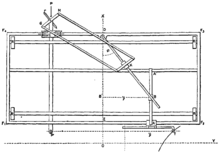Integraph


An Integraph is an instrument used in mathematics for plotting the integral of a graphically defined function.
It was invented independently about 1880 by the British physicist Sir Charles Vernon Boys and by Bruno Abdank-Abakanowicz, a Polish-Lithuanian mathematician/electrical engineer from the Russian Empire. Abakanowicz's design was constructed by Coradi of Zurich.
An integraph consists of a rectangular carriage which moves left to right on rollers, two sides of which run parallel to the x axis on the Cartesian plane. The other two sides are parallel to the y axis. Along the trailing vertical (y axis) rail, slides a smaller carriage holding a tracing point. Along the leading vertical rail slides a second smaller carriage to which is affixed a small, sharp disc, which rests and rolls (but does not slide) on the graphing paper. It will not rotate about its point of contact with the paper. The trailing carriage is connected both with a point in the center of the carriage and the disc on the leading rail by a system of sliding crossheads and wires, such that the tracing point must follow the disc's tangential path.
The integraph plots (traces) the integral curve
when we are given the differential curve,
The mathematical basis of the mechanism depends on the following considerations:[1] For any point (x, y) of the differential curve, construct the auxiliary triangle with vertices (x, y), (x, 0) and (x − 1, 0). The hypotenuse of this right triangle intersects the X-axis making an angle the value of whose tangent is y. This hypotenuse is parallel to the tangent line of the integral curve at (X, Y) that corresponds to (x, y).
The integraph may be used to obtain a quadrature of the circle. If the differential curve is the unit circle, the integral curve intersects the lines X = ± 1 at points that are equally spaced at a distance of π/2.[1]
See also
References
- Granville, William. Elements of Differential and Integral Calculus, New Edition. Ginn and Company. NY, NY, 1934